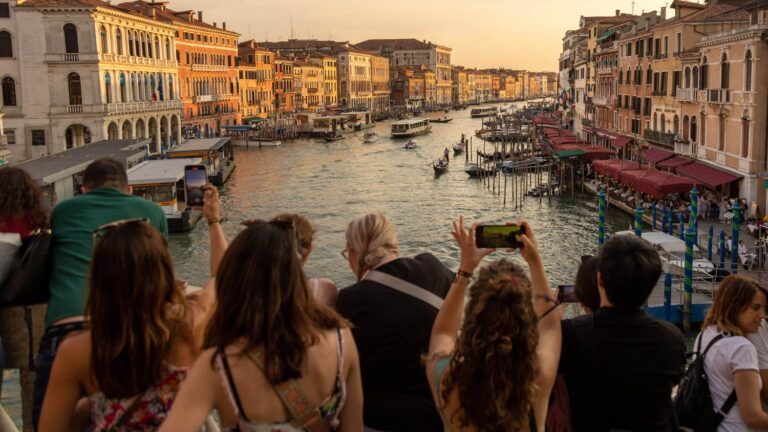Sad but True
Over tourism has become one of the biggest challenges for traditional tourist hotspots. While tourism boosts local economies, it also brings overcrowding, environmental degradation, and rising living costs for residents. To combat these issues, cities across Europe and beyond are implementing new policies to limit excessive tourism while preserving cultural and environmental integrity.
This article explores how some of the world’s most popular tourist destinations—Venice, Florence, and Spain’s Cíes Islands—are handling over tourism, along with expert insights on managing sustainable travel.
What Is Overtourism?

Over tourism occurs when the number of tourists exceeds what a location can sustain, leading to negative impacts such as:
- Overcrowded streets and attractions
- Rising housing prices and rental shortages
- Pollution and environmental strain
- Decreased quality of life for residents
As global travel continues to rise post-pandemic, many iconic locations have reached a tipping point where regulation is necessary.
Venice: Doubling Its Tourist Tax to Reduce Crowds
Venice, Italy, is one of the most overcrowded cities in the world, with millions of tourists visiting annually. In an attempt to manage these overwhelming numbers, the city introduced a €5 “tourist tax” in 2024, applying to day-trippers who visit the city center.
What’s Changing in 2025?
- The fee doubles to €10 for visitors booking less than four days in advance
- The tax applies to 54 peak travel days between April and July
- Overnight guests, local residents, and students are exempt
Expert Insight:
“We are not closing Venice. We simply want to discourage last-minute tourism surges and encourage visitors to plan ahead,” says Simone Venturini, Venice’s Tourism Chief.
According to Business Insider, the move has already reduced peak visitor numbers, generating €2.4 million in revenue to invest in tourism management.
Source: Business Insider
Florence: Banning Key Tourist Rentals & New Hotels
Florence, another major Italian tourist destination, is implementing a strict 10-point plan to limit overtourism:
- Ban on new short-term rentals in the historic city center
- Restrictions on key boxes to prevent illegal Airbnb-style rentals
- No more loudspeakers for tour guides to minimize noise pollution
Local Perspective:
Mayor Sara Funaro emphasized the importance of these changes, stating, “Florence is not an open-air museum; it is a living city, and we need to protect our residents.”
Meanwhile, Italy as a whole saw a record-breaking 134 million arrivals in 2023, and the government wants to increase numbers by another 50 million per year to boost the economy. The challenge is finding the right balance between economic benefits and the well-being of local communities.
Source: AP News
Spain’s Cíes Islands: Strict Visitor Caps for Conservation
Unlike Venice and Florence, Spain’s Cíes Islands (part of the Atlantic Islands National Park) have taken a different approach—they implemented daily visitor caps:
- 1,800 visitors per day between May 15 and September 15
- 450 visitors per day during the off-season
Why It Works
- Environmental Conservation – Protects local wildlife and landscapes
- Better Tourist Experience – Less crowding means a more enjoyable visit
- Sustainability Model – Balances tourism and ecological preservation
Expert Perspective:
“People now understand the importance of limits. This is about protecting the beauty and uniqueness of the Cíes Islands,” says José Antonio Fernández Bouzas, the park’s director. Source: The Guardian
How Experts Suggest Managing Overtourism
Harold Goodwin, managing director of the Responsible Tourism Partnership, stresses that sustainable tourism isn’t about limiting travel, but managing it better.
“Overtourism can often be reversed or averted through effective destination management. This requires engaging with key stakeholders and the local community.”
Other experts, including those at the Sustainable Travel Organization, suggest solutions like:
- Encouraging off-peak travel to reduce pressure on peak seasons
- Promoting lesser-known attractions to distribute visitors more evenly
- Stronger regulations on short-term rentals to free up housing for locals
Source: Responsible Tourism Partnership
Conclusion: The Future of Sustainable Tourism
As international travel continues to grow, balancing tourism and local sustainability is more crucial than ever. Destinations worldwide are now recognizing that overtourism needs proactive management—whether through taxes, visitor caps, or rental regulations.
For travelers, this means being mindful of how tourism impacts local communities and making conscious travel decisions, such as:
- Choosing off-peak travel times
- Supporting locally owned accommodations
- Visiting less crowded destinations
By working together, cities, governments, and travelers can preserve the beauty of the world’s most iconic places while ensuring their longevity for future generations.
What do you think about these tourism regulations? Should more cities adopt similar measures? Let’s discuss in the comments.

